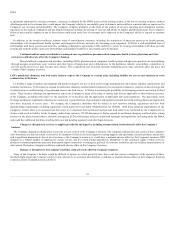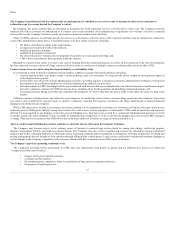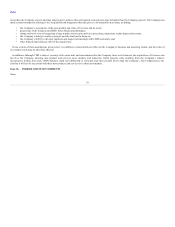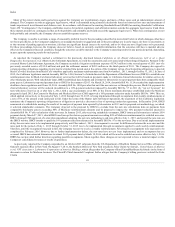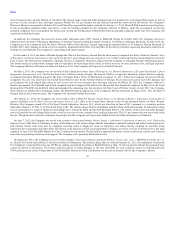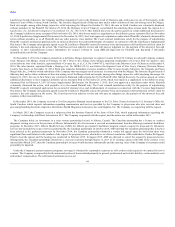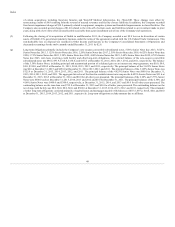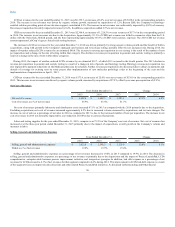LabCorp 2015 Annual Report Download - page 41
Download and view the complete annual report
Please find page 41 of the 2015 LabCorp annual report below. You can navigate through the pages in the report by either clicking on the pages listed below, or by using the keyword search tool below to find specific information within the annual report.
Index
Many of the current claims and legal actions against the Company are in preliminary stages, and many of these cases seek an indeterminate amount of
damages. The Company records an aggregate legal reserve, which is determined using actuarial calculations based on historical loss rates and assessment of
trends experienced in settlements and defense costs. In accordance with Financial Accounting Standards Board (FASB) Accounting Standards Codification
Topic 450 “Contingencies”, the Company establishes reserves for judicial, regulatory, and arbitration matters outside the aggregate legal reserve if and when
those matters present loss contingencies that are both probable and estimable and would exceed the aggregate legal reserve. When loss contingencies are not
both probable and estimable, the Company does not establish separate reserves.
The Company is unable to estimate a range of reasonably probable loss for the proceedings described in more detail below in which damages either have
not been specified or, in the Company's judgment, are unsupported and/or exaggerated and (i) the proceedings are in early stages; (ii) there is uncertainty as
to the outcome of pending appeals or motions; (iii) there are significant factual issues to be resolved; and/or (iv) there are novel legal issues to be presented.
For these proceedings, however, the Company does not believe, based on currently available information, that the outcomes will have a material adverse
effect on the Company's financial condition, though the outcomes could be material to the Company's operating results for any particular period, depending,
in part, upon the operating results for such period.
As reported, the Company reached a settlement in the previously disclosed lawsuit, California ex rel. Hunter Laboratories, LLC et al. v. Quest
Diagnostics Incorporated, et al. (Hunter Labs Settlement Agreement), to avoid the uncertainty and costs associated with prolonged litigation. Pursuant to the
executed Hunter Labs Settlement Agreement, the Company recorded a litigation settlement expense of $34.5 million in the second quarter of 2011 (net of a
previously recorded reserve of $15.0 million) and paid the settlement amount of $49.5 million in the third quarter of 2011. The Company also agreed to
certain reporting obligations regarding its pricing for a limited time period and, at the option of the Company in lieu of such reporting obligations, to provide
Medi-Cal with a discount from Medi-Cal's otherwise applicable maximum reimbursement rate from November 1, 2011, through October 31, 2012. In June of
2012, the California legislature enacted Assembly Bill No. 1494, Section 9 of which directed the Department of Healthcare Services (DHCS) to establish new
reimbursement rates for Medi-Cal clinical laboratory services that will be based on payments made to California clinical laboratories for similar services by
other third-party payers. With stakeholder input, DHCS established data elements and a format for laboratories to report payment data from comparable third-
party payers. Laboratories reported payment data to DHCS in the summer of 2013. On March 28, 2014, Assembly Bill No. 1124 extended the implementation
deadline of new regulations until June 30, 2016. Assembly Bill No. 1494 provides that until the new rates are set through this process, Medi-Cal payments for
clinical laboratory services will be reduced (in addition to a 10% payment reduction imposed by Assembly Bill No. 97 in 2011) by “up to 10 percent” for
tests with dates of service on or after July 1, 2012, with a cap on payments set at 80% of the lowest maximum allowance established under the Medicare
program. In April 2015, the Centers for Medicare and Medicaid Services (CMS) approved a 10% payment reduction under Assembly Bill No. 1494. This cut,
which applied retroactively to the period of July 1, 2012 through June 30, 2015, is being implemented through recoupments from weekly reimbursements at
a rate of 5% of the amount owed until paid in full. Under the terms of the Hunter Labs Settlement Agreement, the enactment of this California legislation
terminates the Company's reporting obligations (or obligation to provide a discount in lieu of reporting) under that agreement. In December 2014, DHCS
announced at a stakeholder meeting the results of its analysis of payment data reported by laboratories in 2013 and its proposed rate methodology, on which
it solicited stakeholder comments. The Company objected to the proposal by DHCS to exclude from the new rate calculations data on payments from
comparable third-party payers exceeding 80% of Medicare reimbursement amounts and its proposal to impose the 10% payment reduction enacted in
Assembly Bill No. 97 after calculation of the new rates. In January 2015, after receiving stakeholder comments, DHCS instructed laboratories to submit 2014
payment data by March 27, 2015, which DHCS used (except for data on payment amounts exceeding 80% of Medicare reimbursement) to establish new rates.
DHCS obtained CMS approval of a state plan amendment adopting the new rate methodology and rates effective July 1, 2015, and posted the new rates on
the DHCS website. DHCS intends to apply the 10% payment reduction referenced in Assembly Bill No. 97 to the new rates. Due to an initial implementation
delay, the new rates were to be implemented prospectively until November 1, 2015. A recoupment to account for differences between the new rates and the
rates paid for the period of July 1, 2015 through October 31, 2015 was to be implemented through recoupments applied to each weekly reimbursement.
Therefore, until the recoupment was paid in full, the Company was not to receive a weekly reimbursement. All retroactive recoupments were expected to be
completed by February 2016. However, due to further implementation delays, the new rates have not yet been implemented, and no recoupment has yet
occurred. DHCS has instructed laboratories to submit 2015 payment data by March 18, 2016, which will be used to establish new rates effective July 1, 2016.
DHHS has not provided further direction regarding possible recoupments. Taken together, these changes are not expected to have a material impact on the
Company's consolidated revenues or results of operations.
As previously reported, the Company responded to an October 2007 subpoena from the U.S. Department of Health & Human Services Office of Inspector
General's regional office in New York. On August 17, 2011, the Southern District of New York unsealed a False Claims Act lawsuit, United States of America
ex rel. NPT Associates v. Laboratory Corporation of America Holdings, which alleges that the Company offered UnitedHealthcare kickbacks in the form of
discounts in return for Medicare business. The Plaintiff's Third Amended Complaint further alleges that the Company's billing practices violated the False
Claims
41



